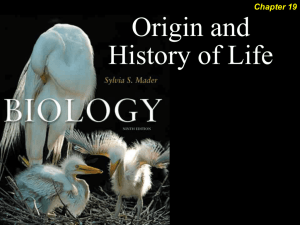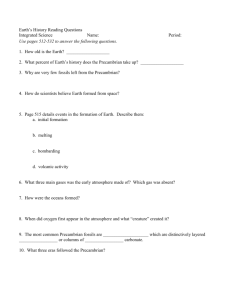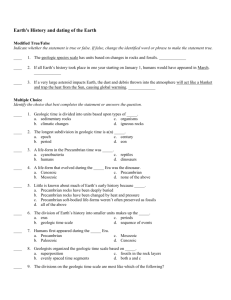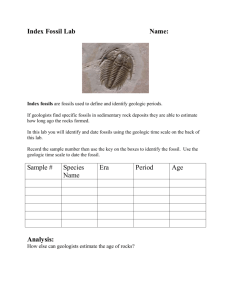The Geologic Time Scale
advertisement
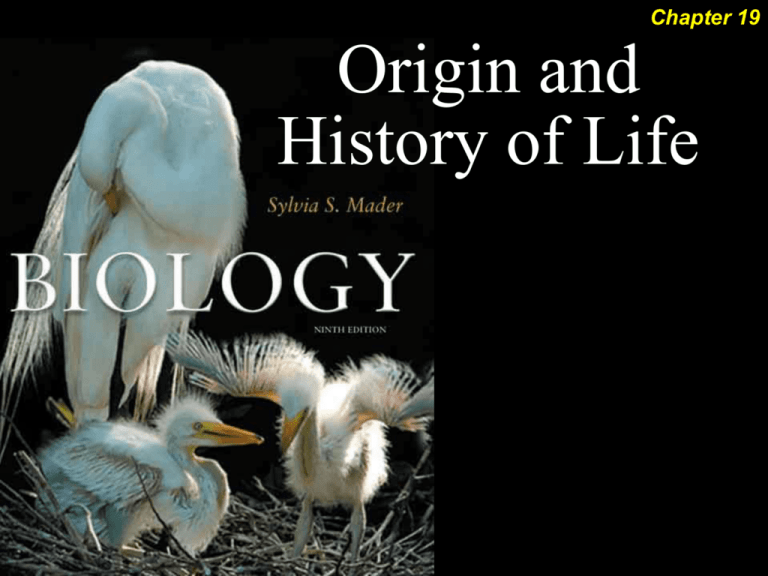
Chapter 19 Origin and History of Life Origin and History of Life Outline Origin of Life Primitive Earth Origin of First Cells History of Life Fossils The Precambrian The Paleozoic The Mesozoic The Cenozoic Factors Affecting Evolution Continental Drift Mass Extinctions 2 Origin and History of Life The Primitive Earth Primitive atmosphere: Most likely consisted of: - Water vapor - Nitrogen - Carbon dioxide - Small amounts of hydrogen and carbon monoxide Little free oxygen Originally too hot for liquid water to form Earth cooled and water vapor condensed to liquid water 3 Origin and History of Life 4 Monomers Evolve Stanley Miller (1953) Conducted an experiment Showed that biochemicals could be produced from simple nonbiological sources - Primitive atmospheric gases - Strong energy sources Led to theory of the Hot Thin Soup Miller’s & Urey’s Apparatus & Experiment. 5 Origin and History of Life Polymers Evolve Monomers join to form polymers in the presence of enzymes Protein-First Hypothesis: - Assumes protein enzymes arose first - DNA genes came afterwards RNA-First Hypothesis: - Suggests only RNA was needed to progress toward formation of the first cell or cells - DNA genes came afterwards 6 Chemical Evolution at Hydrothermal Vents 7 Origin and History of Life 8 Protocell Evolves Protocells: Hypothesized precursors to the first true cells A structure with a lipid-protein membrane that carries on energy metabolism - Semipermeable-type boundary may form around coacervate droplets - Liposomes form spontaneously in liquid environments Protocell Anatomy 9 Origin of the First Cell(s) 10 Fossil Dating: Relative Origin and History of Life 11 Remains and traces of past life Paleontology is the study of the fossil record Most fossils are traces of organisms embedded in sediments Sediment converted to rock Becomes recognizable stratum in stratigraphic sequence of rocks Strata of the same age tend to contain the similar fossil assemblages Helps geologists determine relative dates of embedded fossils despite upheavals Strata 12 Fossils 13 Fossil Dating: Absolute Origin and History of Life 14 One absolute dating method relies on radio (radioactive) dating techniques Half-life: The length of time required for half the atoms to change into something else Unaffected by temperature, light, pressure, etc. All radioactive isotopes have a dependable half life - Some only fractions of a second - Some billions of years - Most in between Many isotopes are used, and their combined half lives make them useful over all periods of interest The Geologic Time Scale: The Precambrian Times Origin and History of Life 15 Includes about 87% of the geological timescale Little or no atmospheric oxygen Lack of ozone shield allowed UV radiation to bombard Earth First cells came into existence in aquatic environments Prokaryotes Cyanobacteria left many ancient stromatolites fossils Added first oxygen to the atmosphere The Geologic Time Scale: Precambrian Times Origin and History of Life 16 Eukaryotic Cells Arise About 2 bya - Most aerobic - Contains nucleus as well as other membranous organelles Endosymbiotic Hypothesis Multicellularity Arises About 1.4 bya Prokaryote Fossil of the Precambrian 17 Ediacaran Fossils 18 The Geologic Time Scale: The Paleozoic Era Origin and History of Life 19 Begins with Cambrian Period Thus all time previous is Pre-Cambrian Lasted over 300 million years Includes three major mass extinction events - Disappearance of a large number of taxa - Occurred within a relatively short time interval (compared to geological time scale) Sea Life of the Cambrian Period 20 The Geologic Time Scale: The Cambrian Period Origin and History of Life High diversity of the Cambrian may be due to the evolution of outer skeletons Molecular Clock: Based on hypothesis that - Changes in base-pair sequences of certain DNA segments occur at fixed rate, and - The rate is not affected by natural selection or other external factors When these base-pair sequences are compared between two species: - Count the number of base-pair differences - Count tells how long two species have been evolving separately 21 The Geologic Time Scale: The Invasion of Land Origin and History of Life 22 Plants Seedless vascular plants date back to Silurian period Later flourished in Carboniferous period Invertebrates Arthropods were first animals on land Outer skeleton and jointed appendages preadapted them to live on land Vertebrates Fishes first appeared in Ordovician Swamp Forests of the Carboniferous Period 23 The Geologic Time Scale: The Mesozoic Era Origin and History of Life Triassic Period Nonflowering seed plants became dominant Jurassic Period Dinosaurs achieved enormous size Mammals remained small and insignificant Cretaceous Period Dinosaurs began precipitous decline Mammals: - Began an adaptive radiation - Moved into habitats left vacated by dinosaurs 24 Dinosaurs of the Mesozoic Era 25 The Geologic Time Scale: The Cenozoic Era Origin and History of Life 26 Mammals continued adaptive radiation Flowering plants already diverse and plentiful Primate evolution began Mammals of the Oligocene Epoch 27 Woolly Mammoth of the Pleistocene Epoch 28 Origin and History of Life 29 Factors That Influence Evolution Plate Tectonics Positions of continents and oceans are not fixed - Earth’s crust consists of slab-like plates - Tectonic plates float on a lower hot mantle layer Movements of plates result in continental drift Modern mammalian diversity results from isolated evolution on separate continents Continental Drift 30 Plate Tectonics 31 Origin and History of Life 32 Mass Extinctions Occurred at the end of the following periods: Ordovician 438 mya 75% of species disappeared Devonian 360 mya 70% of marine invertebrates disappeared Permian 245 mya 90% of ocean species disappeared Triassic 208 mya 60% of species disappeared Cretaceous 66 mya 75% of species disappeared Mass Extinctions 33 Origin and History of Life Review Origin of Life Primitive Earth Origin of First Cells History of Life Fossils The Precambrian The Paleozoic The Mesozoic The Cenozoic Factors Affecting Evolution Continental Drift Mass Extinctions 34 Ending Slide Chapter 19 Origin and History of Life
